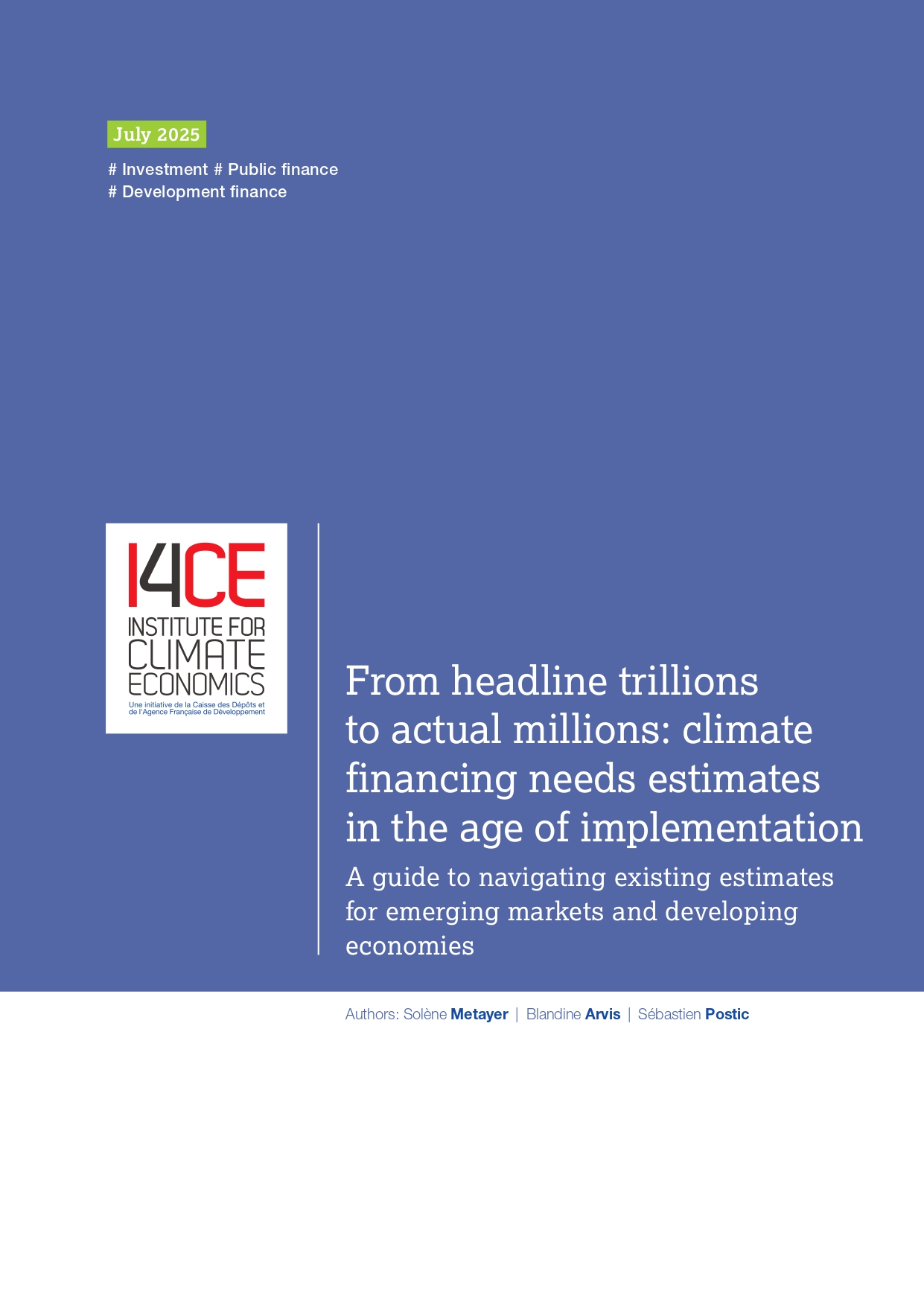From headline trillions to actual millions: climate financing needs estimates in the age of implementation
A guide to navigating existing estimates for emerging markets and developing economies
The longstanding commitment by developed countries to mobilise US$100 billion per year for climate action in developing countries was met in 2022 but no longer matches the scale of climate action needed. Its update through the adoption of the New Collective Quantified Goal (NCQG) on climate finance at COP29 in November 2024 marked a significant political milestone yet left most of the key operational issues unresolved.
As the focus shifts from raising the bar to delivering on these ambitious new goals, this report critically reviews the methodologies and narratives behind existing climate finance needs estimates to understand their relevance in this new context. We examine what these figures represent, how they are constructed, how they might be used to guide practical efforts in the years ahead, and where the most urgent improvements are needed.
Central to this analysis is the Independent High-Level Expert Group on Climate Finance (IHLEG)’s Third Report, titled Raising ambition and accelerating delivery of climate finance (Bhattacharya et al., 2024).
The IHLEG, jointly launched by the COP26 and COP27 Presidencies, provides landmark estimates on the financing needs of the transition and how to meet them. Their third report, published in November 2024, estimates that financing needs for climate action in EMDEs, excluding China, amount to US$2.4 trillion annually by 2030, rising to US$3.3 trillion by 2035. They also provide an indicative breakdown of how this financial burden could be shared across sources. The report takes an unusually broad view, including not only clean energy transition and adaptation costs, but also loss and damage (L&D), natural capital, and just transition expenses. Its estimates come from a variety of sources, each with different assumptions, timelines, and sectoral definitions.
The IHLEG report exemplifies both the ambition and the limitations of current approaches. Its breadth is significant: it spans five pillars of climate action and provides a detailed disaggregation of finance sources and uses. Yet, the supporting data remains fragmented and inconsistent – particularly outside the clean energy sector – and shared understanding is still incomplete even for key concepts, such as what qualifies as a “financing needs estimate.”
By unpacking the IHLEG figure then positioning it within the landscape of existing estimates, this report highlights that the numbers commonly cited in international fora conceal profound differences in scope, ambition, and methodology. Without a clear understanding of the assumptions behind them, they risk misleading rather than informing. Estimates vary by an order of magnitude depending on choices such as whether China is included in EMDE groupings, whether costs of capital are incorporated, or whether the scope is limited to mitigation or extends to adaptation, loss and damage, or other transverse sectors. Each estimate reflects particular assumptions: about the pace and ambition of climate action, about the cost of capital in developing contexts, and about the roles of public versus private finance. These assumptions are rarely made explicit, yet they decisively shape both the headline figures and the narratives built around them.
We thus highlight critical areas for improvement and outline elements for the way forward.
- First, aggregated estimates must be made more internally coherent, or at the very least, more interpretable, by building on existing consistent frameworks.
- Second, the longstanding ambiguity around the additionality of climate finance must be addressed so that discussions in different political fora rely on common premises– particularly in distinguishing between development-aligned and climate-specific investments, and incremental versus total costs. As things stand, estimates differ by orders of magnitude depending on whether they reflect total or incremental costs – and the two are sometimes blended within the same report without clearly defined boundaries.
- Third, and perhaps most crucially, the outlook must shift from abstract investment estimates to actionable financing strategies. This means incorporating cost of capital considerations and specifying financing sources and instruments with their inherent constraints for both public and private actors.
However, decision-makers cannot afford to wait for perfect understanding to start acting. The existing aggregate estimates, however imperfect, were critical to driving agreement on the scale of required climate action but improving them will take time. While the research community must strive to address these quality issues, both researchers and decision-makers must also make the most of what is available now to steer climate action. To do so, it is important to:
- Recognize that incoherent mitigation and adaptation scenarios, combined with poor-quality data, will continue to impede the production of robust estimates of climate financing needs – and acknowledge those figures only as broad indications of where to go. Their real value lies in framing collective understanding and aligning expectations.
- Focus on what else these estimates can tell us – which actors are called to contribute, which instruments should be preferred, what assumptions on cooperation, leverage, investment-trigger are made – and how to make them real
- Identify where mobilisation scenarios diverge most strongly, and how to reconcile them in an ambitious but realistic proposition: in this aspect, the diverging opinions of IHLEG authors and NCQG signatories about the mobilization of private finance should raise questions and clarification attempts
- Work with ranges of uncertainty, whose low and high values are quite often more clear-cut and more easily explained than deceptively neat central values. In this respect, the unique adaptation needs figure used by the IHLEG report is less informative than the two values put forward by the underlying Adaptation Gap Report.
As climate finance debates evolve from pledges to implementation, success will depend less on the precision of funding estimates and more on our ability to convert high-level ambition into credible, inclusive, and actionable financing strategies. From headline trillions to actual millions, the challenge ahead is not just about determining how much is missing – the focus should be on closing this gap in practice.



